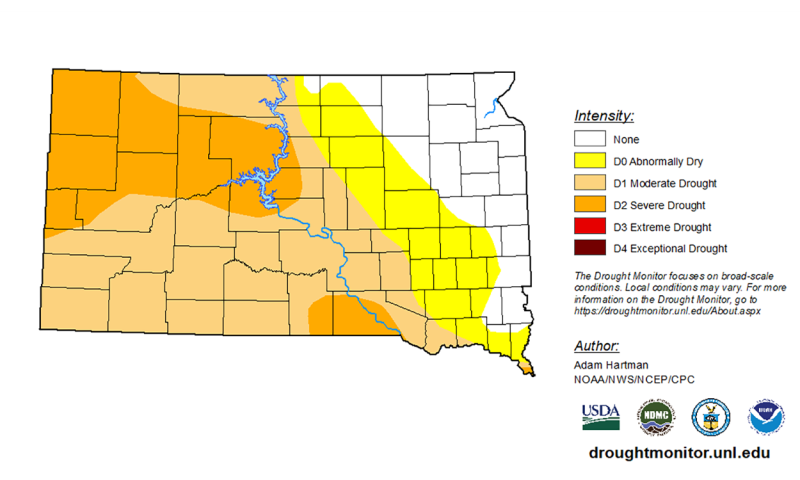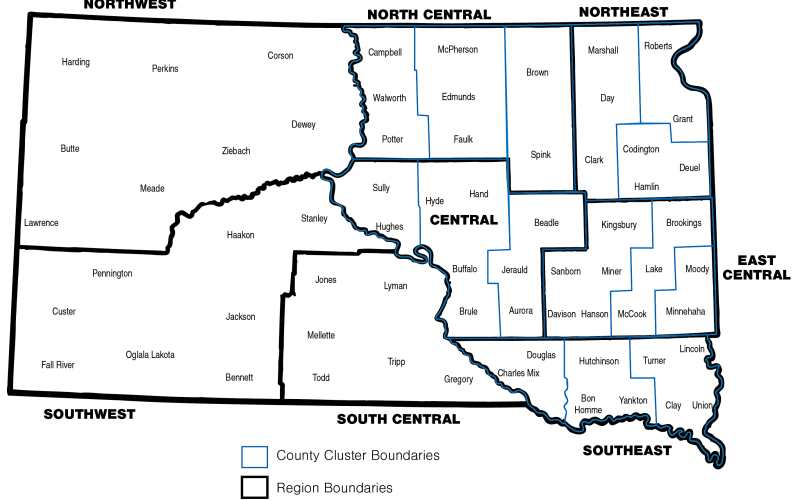
Written with contributions by Jack Davis, former SDSU Extension Crops Business Management Field Specialist.
Despite technological advances, weather factors still play a major role in crop production, especially precipitation. The current U.S. Drought Monitor shows more than two-thirds of South Dakota under abnormally dry to severe drought conditions (Figure 1). If this pattern continues, cropping decisions may need to be adjusted for upcoming growing season.
The current soil moisture stress in South Dakota could be more pronounced than we have seen in last few years because of an abnormally dry and warm 2021. Although, crop producers with established irrigation systems are usually able to manage crop water needs more effectively, some agronomic considerations may prevent the situation from getting worse for producers under dryland management systems.
Pre-Season Planning
Crop Insurance Deadline
March 15 is the sales closing date for crop insurance and the final date to sign up for the farm program choice of Price Loss Coverage, Agricultural Risk Coverage-County or Agricultural Risk Coverage. Producers will need to determine the level of coverage they want to carry this year for crop insurance. The most-used crop insurance product choice in South Dakota is Revenue Protection (RP), with most coverage levels falling between 65% and 75%. Spring projected prices are above 2021 crop years projected and harvest price for crop insurance (Table 1), providing some additional protection for producers.
Prevent plant is available due to drought but is rarely used because of the following:
- Reduced coverage level. 55% of full coverage for corn and 60% of coverage for soybeans.
- It is difficult to establish that it is too dry to complete the crop.
- Using up a year of eligibility of prevent plant when too wet tends to be the reason for prevent plant.
|
|
|
|
|
|---|---|---|---|
| Crop |
|
|
|
| Corn |
|
|
|
| Soybeans |
|
|
|
| Wheat |
|
|
|
Soil Nutrients and Yield Goal
Soil testing is always the best approach to determine crop nutrient needs for economically optimum yields. If a soil nutrient recommendation results in a 0, then follow it.
For example, Olsen Phosphorus (P) soil tests above 16 do not require any P application. Also, yield goals could be adjusted by not applying the aggressive yield trend factor to your Olympic average yield. We need to make sure that we follow sound farming practices to expect crop insurance to cover losses.
The Olympic average yield uses past yield history for the field, zone or grid, excluding obvious high and low yields. We usually recommend multiplying the Olympic average by a yield trend factor between 1.03 and 1.07 to adjust for the increasing yield potential from new seed and other farming practices. However, if one believes the chances of extremely dry climate will be high, the yield trend factor could be omitted.
Omitting the yield trend factor this year will slightly reduce the amounts of fertilizer nutrients required, and therefore slightly improve the economics. We also want to be careful that we do not fall into accepting a drought mentality for crop production. Missing crop production opportunities by not following optimal agronomic recommendations can be costly.
Other nutrient management factors to consider will be fertilizer placement. If frequent rains are not occurring, broadcast fertilizer application will not get into the soil as quickly. Placing nutrients in bands close to the seed is known to improve uptake efficiency. Agronomic planning is extremely important when input prices are very high and supplies are sporadic.
In-Season Crop Management
Insects
Weather factors can influence insect populations quite dramatically, both in favor of and against the growing crops. One of the groups of insects to look out for during hot and dry conditions are grasshoppers. Warmer springs can favor early hatch, which can result in grasshopper populations that are denser and more mature. During hot and dry conditions, grasshoppers may move from less favorable hosts to those that are still green. This can result in serious defoliation depending on the population density. Another important pest of crops during dry conditions are spider mites. Both Banks grass mite and two-spotted spider mite populations can increase in response to drought conditions. Other insects, such as soybean aphids, may also increase during dry conditions but can have population growth that is limited by excessive heat. The real issue that often occurs is when management of one pest (e.g., grasshoppers or soybean aphids) occurs during dry conditions, it can actually lead to outbreaks of spider mites. This is especially true when pyrethroid insecticides are used for management. This chemistry is known to remove natural enemies of spider mites, which allows their populations to rapidly grow.
Nitrates in Forages
Nitrates in forage crops when converted to nitrites can cause increased toxicity to livestock. Under drought conditions, plants cannot effectively metabolize nitrates into protein and amino acids. These nitrates can build up in plant tissues (especially in lower parts) and cause toxicity when fed to livestock. As grass forages are more likely to be fertilized with nitrogen, it is recommended to test for nitrates when these crops are grown under drought conditions.
Nutrient Deficiency Symptoms
Under dry conditions, plants may show moderate-to-severe nutrient deficiency symptoms, even when the soil contains an adequate amount of nutrients needed for normal growth and development. These symptoms could be in the whole field or on a small area.
One of the major nutrients that could be harder for plants to extract during moisture deficit situations is potassium. When the field shows deficiency symptoms, a good practice would be to sample soil and plant tissues from good and bad portions of the field and conduct nutrient analyses on both sets of samples to confirm the presence (or absence) of these nutrients. Further, if the dry (granular) nitrogen fertilizer is applied late, it may stay on the soil surface for prolonged periods of time and not be readily available to the plant as roots are penetrating deeper in the soil for resources. This will cause plants to show nitrogen deficiency symptoms.
Weed Control
Weeds under drought conditions tend to show more tolerance to applied herbicides than those growing under optimal conditions, because plants may develop a thicker wax layer on the leaf surface to conserve moisture, which can obstruct the herbicide absorption.
Herbicides applied during highly stressful environmental conditions may cause unwanted injuries to already stressed crops and not affect weeds as intended. Systemic herbicides, such as Roundup and SU herbicides, are known to have reduced effects during hot and dry conditions.


